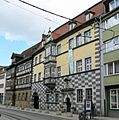Erfurt facts for kids
Quick facts for kids
Erfurt
|
|||
|---|---|---|---|

Krämerbrücke from above
|
|||
|
|||
| Country | Germany | ||
| State | Thuringia | ||
| District | Urban district | ||
| Subdivisions | 53 districts | ||
| Elevation | 158-430 m (−1,252.8 ft) | ||
| Population
(2022-12-31)
|
|||
| • Total | 214,969 | ||
| Time zone | CET/CEST (UTC+1/+2) | ||
| Postal codes |
99001-99198
|
||
| Dialling codes | 0361 | ||
| Vehicle registration | EF | ||
| Website | www.erfurt.de | ||
Erfurt is the capital city of the German state of Thuringia. It has an area of 269.17 km2 (103.9 sq mi). In December 2015 it had a population of 210,000 people. The River Gera runs through the city.
History
People have lived in the area for about 100,000 years. The city was first mentioned in writing in 742, in a letter to the Pope from St Boniface. St Boniface established Christianity in the area. He set up a church in Erfurt in 742. Erfurt Cathedral was later built on the same site.
The city is in the centre of Germany. It was on the Via Regia, a medieval trade road network that stretched across Europe. It became an important trading centre in the Middle Ages. Erfurt was a member of the Hanseatic League, an alliance of trade associations and market towns. It was also famous for producing woad. Blue indigo dye is made from the woad plant.
Erfurt is on the Way of St. James pilgrams' path (Spanish: Camino de Santigo; German: Jakobsweg). In the Middle Ages a number of monasteries were set up in the city. Martin Luther, the father of the Reformation, lived at St. Augustine's Monastery from 1505 until 1511. A famous philosopher and theologian called Meister Eckhart lived at the Dominican Monastery from about 1275 until 1311.
The city was part of the Holy Roman Empire. It became part of the Kingdom of Prussia in 1802. From 1949 until 1990 Erfurt was in the communist German Democratic Republic (East Germany).
Industry
Modern day Erfurt is a transport hub for high speed trains and other German and European transport networks. This makes logistics one of its main industries. Other important industries are agriculture, horticulture and microelectronics.
The German Federal Labour Court (German:Bundesarbeitsgericht) is in Erfurt.
Education
The University of Erfurt was first set up in 1379. It closed in 1816, but was reopened in 1994. Martin Luther studied there from 1501 to 1505. It is also thought that Johannes Gutenberg, who developed the printing press, enrolled there in 1418. Erfurt also has a Fachhochschule, a University of Applied Sciences.
Tourist attractions
Many visitors come to see the historic medieval town centre. One of the main tourist attractions is the Krämerbrücke (the Merchants' Bridge). The bridge was built in its current form in 1472. It has buildings with shops and houses on it. People still live on it.
The city is well known for its festivals throughout the year. Two million people visit the Christmas markets each year.
Other important sites in the city include:
- St. Augustine's Monastery, where Martin Luther lived from 1505 to 1511. It has been nominated as a World Heritage Site.
- The Old Synagogue, which dates back to the 11th and 12th centuries. It is one of the oldest synagogues in Europe and it has been nominated as a World Heritage Site.
- Erfurt Cathedral and the Severikirche (St. Severus Church), which overlook Domplatz, the Cathedral square.
- Petersberg Citadel, a 16th-century fortress on a hill overlooking the town centre. It is one of the largest and best preserved town fortresses in Europe.
Gallery
Images for kids
-
Die Napoleonshöhe im Steiger bei Erfurt, painted by Nikolaus Dornheim in 1812. Inaugurated in March 1811 to celebrate Napoleon's birthday, this Greek-style temple with grotto, flowerbeds and fountain in the Stiegerwald was burned in November 1813 and completely destroyed by Erfurters and their besiegers in 1814.
-
Housing projects in Bauhaus style from 1930
See also
 In Spanish: Érfurt para niños
In Spanish: Érfurt para niños












































































